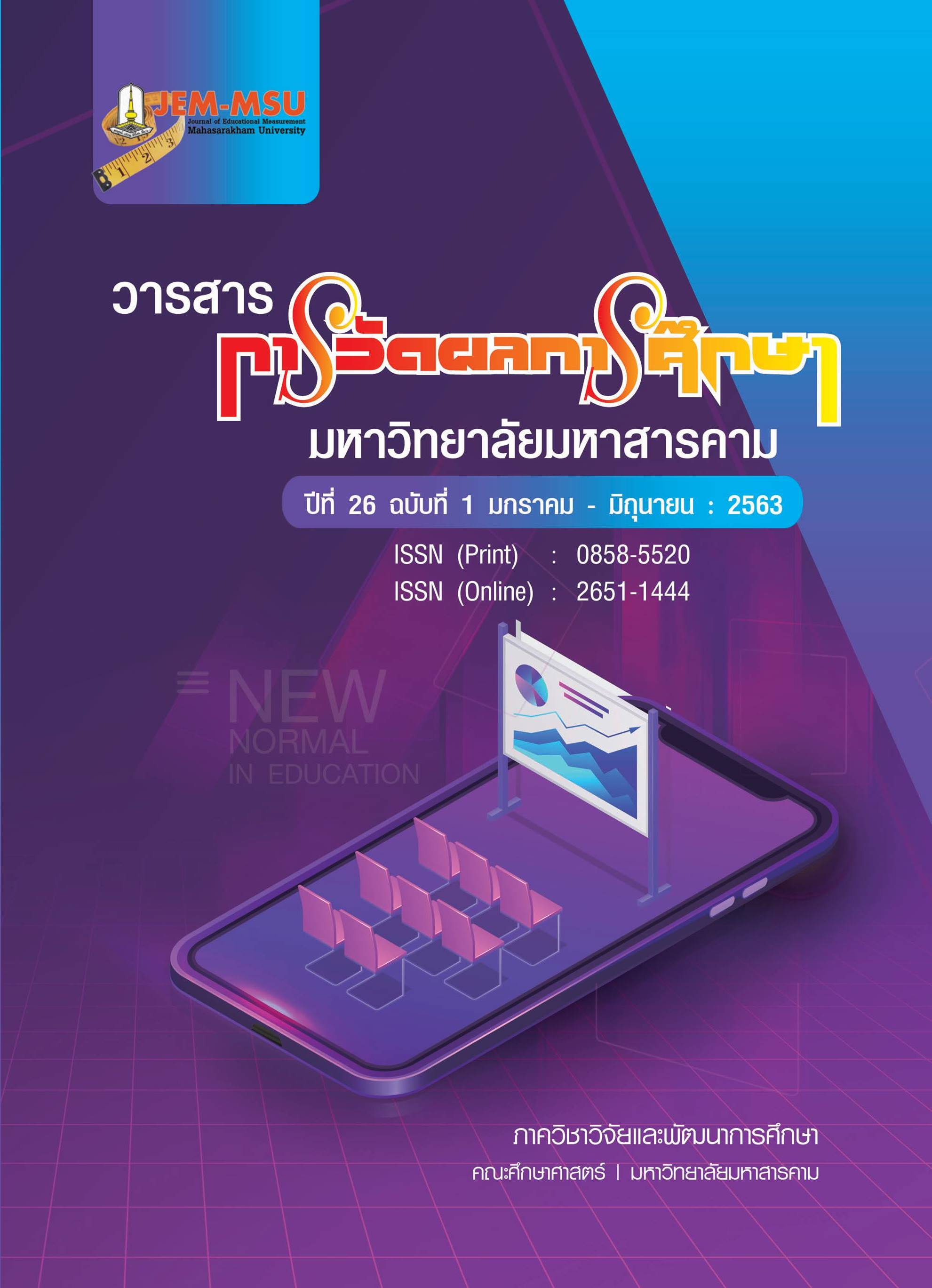Discriminant Factors of Undergraduate Dropouts in Mahasarakham University
Main Article Content
Abstract
The objectives of this study were: 1) to study the factors that are related to the dropping out of Mahasarakham University students in the 1st year of undergraduate degree; 2) to formulate a discriminant equation of the dropping out of Mahasarakham University students in the 1st year of undergraduate degree; and 3) to study guidelines on decreasing the dropout rate of the 1st year undergraduate students of Mahasarakham University. This research was conducted quantitatively and qualitatively. The sample consisted of 239 1st year students who enrolled in courses for at least one semester in 2015 at Mahasarakham University, obtained through stratified random sampling, and 5 1st year students who attended classes for at least one semester in 2015 at Mahasarakham University, obtained through purposive sampling. The instruments used in this study were a 5-point Likert scale questionnaire for formulation of discriminant equation of undergraduate students’ dropping out, and an interview form. The statistics employed were the mean and standard deviation. The discriminant analysis using stepwise method proposed by Wilk’s Lambda was also used in this study.
The results revealed that:
1. There were 2 factors which could discriminate the 1st year undergraduate students’ dropping out at Mahasarakham University. They were students’ problems (X1) and family problems (X3). The two factors affected the discriminant equation with the students who were studying and the students who had dropped out, with statistical significance at the .01 level, and predicted group membership of the students who were studying and the students who had dropped out at 76.60% accurate. The discriminant equation in the form of raw scores and standard scores are shown as follows:
Discriminant equation in the form of raw scores
= -8.805 + 2.832X1* - .492X3
Discriminant equation in the form of standard scores
= 1.097Z1* - .297Z3
2. The guidelines on decreasing the number of the 1st year undergraduate dropouts at Mahasarakham University are as follows:
1) On the student aspect, there should be activities for adjusting student’s attitudes toward a favorable path for education. Responsibility for one’s own duty should be instilled in students, and students should be promoted to adjust themselves to living together on campus.
2) On the family aspect, the university ought to support students in education, family income and relationship within the family by holding meetings in order for parents to gain understanding of learning and teaching in each field. The university should elucidate how it promotes student’s part time jobs as well as how to find ways together to solve students’ problems.
Article Details
The content and information contained in the published article in the Journal of Educational Measurement Mahasarakham University represent the opinions and responsibilities of the authors directly. The editorial board of the journal is not necessarily in agreement with or responsible for any of the content.
The articles, data, content, images, etc. that have been published in the Journal of Educational Measurement Mahasarakham University are copyrighted by the journal. If any individual or organization wishes to reproduce or perform any actions involving the entirety or any part of the content, they must obtain written permission from the Journal of Educational Measurement Mahasarakham University.
References
แคทลียา ทาวะรมย์. (2548). การประยุกต์ใช้การวิเคราะห์การอยู่รอดในการศึกษาการออกกลางคันของนิสิตระดับปริญญาบัณฑิต คณะวิศวกรรมศาสตร์ จุฬาลงกรณ์มหาวิทยาลัย. วิทยานิพนธ์ ค.ม. กรุงเทพฯ: จุฬาลงกรณ์มหาวิทยาลัย.
จรัญ ยินยอม. (2552). การศึกษาปัจจัยที่เกี่ยวข้องกับการออกกลางคันของนักศึกษามหาวิทยาลัยราชภัฏพระนครศรีอยุธยา. วิทยานิพนธ์ ศศ.ม. พระนครศรีอยุธยา: มหาวิทยาลัยราชภัฏพระนครศรีอยุธยา.
ธงชาติ สอนคา. (2554). การศึกษาปัญหาการออกกลางคันของนักเรียนโรงเรียนบ้านกล้อทอ สังกัดสานักงานเขตพื้นที่การศึกษาประถมศึกษาตาก เขต 2. การค้นคว้าอิสระ ค.ม. ราชบุรี: มหาวิทยาลัยราชภัฏหมู่บ้านจอมบึง.
นฤชล พิมพ์สว่าง. (2553). การวิเคราะห์สาเหตุและการแก้ปัญหาการออกกลางคันของนักเรียนชนเผ่าในโรงเรียนมัธยมศึกษาบนเขตพื้นที่สูง: กรณีศึกษาโรงเรียนแห่งหนึ่งในจังหวัดลำปาง. การศึกษาค้นคว้าอิสระ ศศ.ม. นนทบุรี: มหาวิทยาลัยสุทัยธรรมาธิราช.
ภูษณิศา สิริวรพร. (2557). สาเหตุของการออกกลางคันและแนวทางแก้ไขปัญหาการออกกลางคันของนักศึกษาชั้นปีที่ 1 ที่เข้าศึกษาต่อในระดับปริญญาตรีของสถาบันการพลศึกษา ภาคตะวันออกเฉียงเหนือ. วิทยานิพนธ์ กศ.ม. มหาสารคาม: มหาวิทยาลัยมหาสารคาม.
มัย สุขเอี่ยม. (2524). ความคิดเห็นของครู นักเรียน และผู้ปกครองเกี่ยวกับสาเหตุการขาดเรียน การออกกลางคันของนักเรียนในแหล่งเสื่อมโทรมคลองเตย กรุงเทพมหานคร. ปริญญานิพนธ์ กศ.ม. กรุงเทพฯ: มหาวิทยาลัยศรีนครินทรวิโรฒประสานมิตร.
วัชรี ตระกูลงาม และคณะ. (2550). ปัจจัยที่ส่งผลกระทบต่อการออกกลางคันของนักศึกษามหาวิทยาลัยราชภัฏสวนดุสิต. วิทยานิพนธ์ ค.ม. กรุงเทพฯ: มหาวิทยาลัยราชภัฏสวนดุสิต.
รุจิรา อุ้ยปัชฌาวงศ์. (2554). การวิเคราะห์ปัจจัยจำแนกการออกกลางคันของนักเรียน หลักสูตร ประกาศนียบัตรวิชาชีพ (ปวช.) วิทยาลัยการอาชีพแก้งคร้อ จังหวัดชัยภูมิ. วิทยานิพนธ์ กศ.ม. มหาสารคาม: มหาวิทยาลัยมหาสารคาม.
ลำปาง พันธ์เพชร. (2558). ข้อเสนอการแก้ไขปัญหาการออกกลางคันของนักเรียนระดับ ปวช. วิทยาลัยเทคนิค ร้อยเอ็ดคณะกรรมการการอาชีวศึกษา. วิทยานิพนธ์ ค.ม. มหาสารคาม: มหาวิทยาลัยราชภัฏมหาสารคาม.
ศรีเรือน แก้วกังวาน. (2538). จิตวิทยาเด็กที่มีลักษณะพิเศษ. พิมพ์ครั้งที่ 2 กรุงเทพฯ: หมอชาวบ้าน.
สุภาภรณ์ พิมพะนิตย์. (2555). สาเหตุการออกกลางคันของนิสิตมหาวิทยาลัยมหาสารคาม. วิทยานิพนธ์ รป.ม. มหาสารคาม: มหาวิทยาลัยมหาสารคาม.
สำนักงานปลัดกระทรวงศึกษาธิการ. (2540). รายงานผลการวิจัยเรื่อง ปัจจัยที่ส่งผลต่อการออกกลางคันของนักเรียนชั้นมัธยมศึกษาตอนต้น. กรุงเทพฯ: สำนักนโยบายและแผนการศึกษา ศาสนาและวัฒนธรรม.
สำนักงานเลขาธิการสภาการศึกษา. (2546). รูปแบบการบริหารจัดการสถาบันอุดมศึกษาแนวใหม่ (Management Innovation in Higher Education). กรุงเทพฯ: ภาพพิมพ์.
อัมพร โอตระกูล. (2524). “ปัญหาเด็กเรียนไม่ดี,” ใกล้หมอ. 5(9): 31-33; กันยายน.
Morcke AM, O’Nell L, Kjeldsen IT, B. Eika. (2012). “Selected Determinants May Account for Dropout Risks Among Medical Student,” Dissertation Abstracts International. 59(9): 4493 - A; September.


